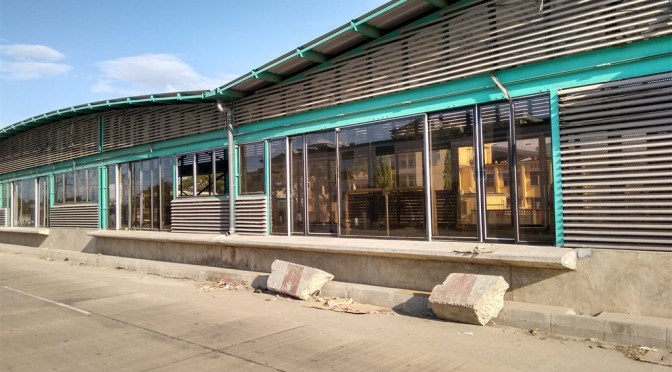Let’s do a little thought experiment to visualize the challenges faced by many developing countries. Imagine a country with a population growth of 5% and economic growth of 3% per year. The standard of living in year 0 would be 100%. Where would that country be after twenty years?
| annual growth | year 0 | year 20 | |
| Economy | 3% | 100% | 180% |
| Population | 5% | 100% | 265% |
| Standard of living | -2% | 100% | 68% |
In poor societies population sizes often double in two or three decades. As a result, industries, housing, schools, health clinics, and infrastructure must be built at least at the same rate in order for standards of living not to deteriorate. But, economically put, the demand is often growing faster than the supply. Finite resources like water, wood and land will run out even faster.
In the case of public transport Dar es Salaam has decided to push ahead with a Bus Rapid Transit system that’s currently being installed. It consists of dedicated bus lanes and raised bus stops that will provide a level entrance into the buses at 1 m height. Kind of a “subway” on the street.
 German company STRABAG is building the whole system and German orange rubbish bins are already installed. I have not seen many other rubbish bins in the rest of Dar es Salaam and I think it might be here where some level of disconnect shows.
German company STRABAG is building the whole system and German orange rubbish bins are already installed. I have not seen many other rubbish bins in the rest of Dar es Salaam and I think it might be here where some level of disconnect shows.
All stations are designed for wheelchairs. In some end stations like Ubungo or Morocco huge overpasses have been built that wind twice around the pillars to gain height to pass the road. Inclusiveness is important and certainly there is a lot of development money in it. Having seen a beggar on a wheelchair being pushed by a young fellow I wonder if BRT will be for him.
A sliding door system will be operating in all stations and I wonder what happens if the mechanism breaks down. Will there be someone to fix it or will it be considered too expensive to maintain and unnecessary to have sliding doors?

A bus ride costs around TZS 400 (USD 0.20) and covers about 7 km in an hour. What will the new bus system cost and how will it deliver on the promise of speed? Having seen the traffic in Dar es Salaam I guess it will take some time (and well-timed traffic lights) to instill a level of discipline to keep the bus lanes free. I’ve seen reckless drivers tying to escape a congestion by driving their car over the lane separation ledge. It was a frantic exercise and took a while. At some places cars are allowed to cross the bus lane to reach a particular side road. This is sometimes the pivot point for a small jam.
“It is expected that full fledge BRT services will begin mid 2016 after total completion of the first phase.”
(information from DART website)
An other key issue that BRT “solves” is the payment queue. It’s done through prepayment. To me it looks like a solution to a problem that’s not there. In Bangkok and in Dar es Salaam I have come across bus fare collectors who performed useful services by making the passengers move to free spots, getting more customers on board, help loading and unloading large parcels of goods and finding a spot to stand even when the bus was really full. Collecting the fare during or at the end of a trip was never an issue and didn’t lead to noticeable delays.

It will be interesting to experience the piloting in September 2015 and see the system fully operating mid 2016.

(source DART)



Just met a project manager from Strabag. He confirmed that the the project in fact ticked the inclusiveness and the reproductive health boxes. The former led to the over-sized overpasses and the later was fulfilled by informing everyone living on this street about how to protect against HIV. The project is by now over cost and over time. But the World Bank funding is ensuring good quality. The road consists of large concrete slabs with expansion joints, each poured in situ with a thickness of 60 cm. Some of them are defective and are currently replaced. The German engineer himself is a bit doubtful how buses running at 60 km/h with phased traffic lights and local vehicles will go together. The fancy sliding doors will last only half a day according to him. He mentioned the complex setup of World Bank (donor), Strabag (contractor), SMEC (planners) and DART (local operator) is not making things any easier. But he is proud of what they’ve built. He said it was a challenge to get a project of this size done in a city like Dar es Salaam.
LikeLike
classic example of the question of relevance. First world approach to third world challenges may not always make sense.
LikeLike
Hi Terence, thanks for your thought. Tanzania turns out to be some kind of NGO paradise where thousands of organizations have come for a spot in the sun and a house in the better parts of town. The big five (national aid organizations) are here and even though billions of dollars have been spent and invested, Tanzania is a bit slow in picking itself up.
LikeLike